|
| |
|
Electric Bilge Pump
I chose a Rule 2000GPH electric pump with a
5 year guarantee, along with a Super float switch and cover. The
deepest point in the bilge was located at the forward end of the engine
room, and it was here that I chose to install the pump.
The installation was complicated by the
fuel tank platform that spanned the bilge directly above this area,
meaning that good access to the area required lying prone and upside
down in the bilge. With plenty of room inside the bilge beneath
the cockpit, this position was less uncomfortable than on many boats,
but it was still quite an act of contortion to get into position.
Of course, once there, I realized that I had forgotten one crucial tool
or another, so I ended up back and forth several times before succeeding
with the pump's raw installation. |
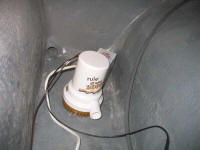 I screwed the pump base/strainer to the bottom of the bilge, knowing
that there was sufficient thickness of material there, and sealed the
screwholes with polysulfide. The float switch snapped right onto
the strainer, and then I installed the pump with the outlet facing aft.
I made up the pump wires, using adhesive-lined heat shrink connectors,
and tied them up to the bottom of the platform above, thereby keeping
the connections and wires out of the bilge entirely. I screwed the pump base/strainer to the bottom of the bilge, knowing
that there was sufficient thickness of material there, and sealed the
screwholes with polysulfide. The float switch snapped right onto
the strainer, and then I installed the pump with the outlet facing aft.
I made up the pump wires, using adhesive-lined heat shrink connectors,
and tied them up to the bottom of the platform above, thereby keeping
the connections and wires out of the bilge entirely. |
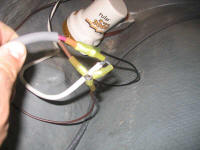 With the wiring (and test run) complete, I continued with the hose and
through hull fitting. I chose a 3/4" bronze mushroom fitting, and
installed the fitting in the counter, opposite from the engine exhaust
on the port side. The pump outlet called for 1-1/8" hose, but you
simply cannot buy quality hose of this size (only the terribly junky
corrugated hose marketed as bilge pump hose), and cannot find bronze
through hull fittings in this size either. Since I refused to
knowingly place materials of poor quality in the boat, I decided to
downsize the hose--using a small Rule adapter at the pump--to 3/4",
allowing me to use the materials of my choice. This would, of
course, limit the ultimate capacity of the pump, but since the pump
existed for nuisance dewatering only, this was of no concern. With the wiring (and test run) complete, I continued with the hose and
through hull fitting. I chose a 3/4" bronze mushroom fitting, and
installed the fitting in the counter, opposite from the engine exhaust
on the port side. The pump outlet called for 1-1/8" hose, but you
simply cannot buy quality hose of this size (only the terribly junky
corrugated hose marketed as bilge pump hose), and cannot find bronze
through hull fittings in this size either. Since I refused to
knowingly place materials of poor quality in the boat, I decided to
downsize the hose--using a small Rule adapter at the pump--to 3/4",
allowing me to use the materials of my choice. This would, of
course, limit the ultimate capacity of the pump, but since the pump
existed for nuisance dewatering only, this was of no concern. |
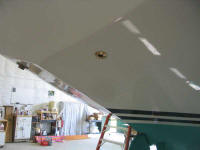 Next, I ran a length of 3/4" reinforced polyethylene hose between the
pump and the transom outlet, securing the hose to bulkheads and other
members as required with rubber-lined stainless steel clamps.
Then, I used hose clamps to secure the hose at each end, completing the
installation. Next, I ran a length of 3/4" reinforced polyethylene hose between the
pump and the transom outlet, securing the hose to bulkheads and other
members as required with rubber-lined stainless steel clamps.
Then, I used hose clamps to secure the hose at each end, completing the
installation. |
|
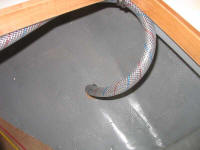
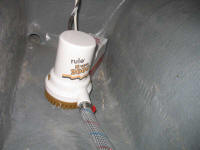
|
Earlier, during the wiring stage, I installed a 3-way switch for the
bilge pump at the main service panel, to which the pump was now wired. |
|
Back to
the Main Menu> |
|
|
|
